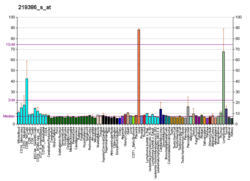SLAMF8
SLAM family member 8 is a protein that in humans is encoded by the SLAMF8 gene.[5][6]
Function
This gene encodes a member of the CD2 family of cell surface proteins involved in lymphocyte activation. These proteins are characterized by Ig domains. This protein is expressed in lymphoid tissues, and studies of a similar protein in mouse suggest that it may function during B cell lineage commitment. The gene is found in a region of chromosome 1 containing many CD2 genes.[6]
gollark: How do you end up with a stupidly large civilization but barely any life extension stuff?
gollark: I'm wondering how many 32 bit Unix systems will be around in 2038. Probably a lot. Inevitably a few will be in some sort of critical system.
gollark: Also, everyone knows that time begins in 1970, not 1999.
gollark: It's probably better than current Earth, but not exactly a wonderful society to live in.
gollark: Me two.
References
- GRCh38: Ensembl release 89: ENSG00000158714 - Ensembl, May 2017
- GRCm38: Ensembl release 89: ENSMUSG00000053318 - Ensembl, May 2017
- "Human PubMed Reference:". National Center for Biotechnology Information, U.S. National Library of Medicine.
- "Mouse PubMed Reference:". National Center for Biotechnology Information, U.S. National Library of Medicine.
- Kingsbury GA, Feeney LA, Nong Y, Calandra SA, Murphy CJ, Corcoran JM, Wang Y, Prabhu Das MR, Busfield SJ, Fraser CC, Villeval JL (May 2001). "Cloning, expression, and function of BLAME, a novel member of the CD2 family". Journal of Immunology. 166 (9): 5675–80. doi:10.4049/jimmunol.166.9.5675. PMID 11313408.
- "Entrez Gene: SLAMF8 SLAM family member 8".
Further reading
- Tangye SG, Nichols KE, Hare NJ, van de Weerdt BC (September 2003). "Functional requirements for interactions between CD84 and Src homology 2 domain-containing proteins and their contribution to human T cell activation". Journal of Immunology. 171 (5): 2485–95. doi:10.4049/jimmunol.171.5.2485. PMID 12928397.
- Zhang Z, Henzel WJ (October 2004). "Signal peptide prediction based on analysis of experimentally verified cleavage sites". Protein Science. 13 (10): 2819–24. doi:10.1110/ps.04682504. PMC 2286551. PMID 15340161.
This article is issued from Wikipedia. The text is licensed under Creative Commons - Attribution - Sharealike. Additional terms may apply for the media files.





